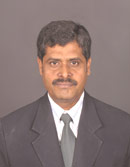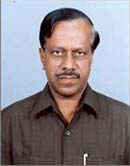Contents: 2024 | 2023 | 2022 | 2021 | 2020 | 2019 | 2018 | 2017 | 2016 | 2015 | 2014 | 2013 | 2012 | 2011 | 2010 | 2009 | 2008 | 2007 | 2006 | 2005 | 2004 | 2003 | 2002 | 2001
2008, 20
Tamil speech recognition: a complete model
language: English
received 12.11.2008, published 11.12.2008
Download article (PDF, 470 kb, ZIP), use browser command "Save Target As..."
To read this document you need Adobe Acrobat © Reader software, which is simple to use and available at no cost. Use version 4.0 or higher. You can download software from Adobe site (http://www.adobe.com/).
ABSTRACT
The paper presents a new method to build a speech recognition system to recognize spoken Tamil. Continuous speech recognition in Tamil is a long desire of the researchers in Tamil computing. This paper presents an algorithm developed for segmenting the speech signal and then a segment-based recognition system. The new approach segments the words from the speech and then characters from words. Then back propagation algorithm is used to train and identify the segmented characters. The proposed method is used to train and test the speech of a given individual. It can be extended to work independent of individuals. The system developed is found to be efficient and effective.
15 pages, 6 figures
Сitation: M. Chandrasekar, M. Ponnavaikko. Tamil speech recognition: a complete model. Electronic Journal “Technical Acoustics”, http://www.ejta.org, 2008, 20.
REFERENCES
1. M. Chandrasekar, M. Ponnavaikko. A Survey of methods used for Speech processing and the issues related to Indian Language Processing. Int. Conference on Spoken language processing. New Delhi, India, October 2002.
2. Davis K. H., Biddulph R., Balashek S. Automatic recognition of spoken digits. Journal of Acoust. Soc. of America, volume 24, pp. 637–642, 1952.
3. Olson H. F., Belar H. Phonetic Typewriter. Journal of Acoust. Soc. of America, 28(4), 1072–1081, 1956.
4. Fry D. B. Theoretical aspects of mechanical speech recognition. J. British Inst. Radio Engineer, 19(4), 211–218, 1959.
5. Forgie J. W., Forgie C. D. Results obtained from vowel recognition Computer program. J. Acoust. Soc. of America. 31(11), 1480–1489, 1959.
6. Sakai T., Doshita S. The phonetic typewriter. Information Processing. Proc. IFIP Congress, Munich, 445–450, 1962.
7. T. B. Martin, A. L. Nelson, H. J. Zadell. Speech recognition by feature extraction techniques. Tech. Report AL-TDR-64-176, Air Force Avionics Lab, 1964.
8. T. K.Vintsyuk. Speech discrimination by dynamic programming. Kibernetika, 4(2), 81-88, January-February, 1968.
9. D. R. Reddy. An approach to computer speech recognition by direct analysis of the speech wave. Tech. Report C549, Computer Science Dept., Stanford Univ., September 1966.
10. V. M. Velichko, N. G. Zagoruyko. Automatic recognition of 200 words. Int. J.Man-Machine Studies, 2:223, June 1970.
...
78. Chalapathi Neti, Nitendra Rajput, Ashish Verma. A large vocabulary continuous speech recognition system for Hindi. IIT, Bombay, Jan. 2000.
79. Paul Mermelstein. Automatic segmentation of speech into syllabic units. J. Acoust. Soc. Am., vol. 58, no. 4, October 1975.
80. Andre G. Adamiand and Hynek Hermansky. Segmentation of speech for speaker and language recognition. EUROSPEECH, Geneeva, 2003.
81. Ramil G. Sagum, Ryan A.Ensono, Emerson M. Tan, Rowena Christiana L. Guevara. Phoneme alignment of Filipino speech corpus. Conference on convergent technologies for Asia Pacific Region, vol. 3, 964–968, Oct. 2003.
82. A.Lipeika, G.Tamulevicius. Segmentation of words into phones. ISSN 1392-1215, Electronics and Electrical Engineering, 1(65), 2006.
83. R. W. Schafer, L. R. Rabiner. Digital representations of speech signals. Proc. IEEE, vol. 63, no. 4, April 1975.
 |
M. Chandrasekar received his M.E. degree from Madras Institute of Technology in 1987. He is doing research in recognizing Tamil sentences. He has 12 years of industrial experience and 15 years of teaching experience. He is now serving as Professor & Head, Computer Science and Engineering Department, RVS College of Engineering and Technology, Coimbatore, Tamilnadu, India. e-mail: chandramu2000(at)yahoo.co.in |
|
 |
Murugesan Ponnavaiko is a graduate in Electrical Engineering and a Post graduate in Power System Engineering, from the College of Engineering Guindy. He received his PhD degree in Optimal Distribution System Planning from I.I.T.(Delhi) in 1983. He has proven record of excellence as Technologist, Administrator, Academic and Leader. He started his carrier from Tamil Nadu Electricity Board in 1972 and had seventeen years of eventful service as Consultant and Administrator in the Public Power Sectors in India and abroad. He entered into the Academic World in 1986 as a Professor of Electrical Engineering and taught power system courses for three years in Libya. From 1989 till June 2000, he served as the Professor and Head, Dept. of CSE, initially at Mookambigai college of Engineering, then at Regional Engineering College, Tiruchirapalli, and later at the Crescent Engineering College, Chennai. He then served as the Director, at the level of Vice-Chancellor at the Tamil Virtual University from July 2000 till August 2003. Then, served as the Director, Research and Virtual Education at the SRM University from September 2003 till 10th July 2007. At present he is the Vice-Chancellor, Bharathidasan University, Tamilnadu. e-mail: ponnav(at)gmail.com |
|
